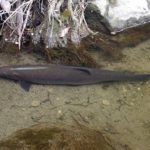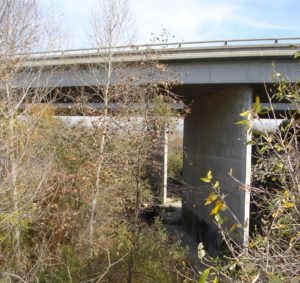
Steelhead protection effort sinks in North San Diego County
Raises questions about future of larger projectsBy Mike Lee
Published in: The San Diego Union-TribuneMonday, January 24, 2011 at 1:28 p.m.
Southern steelhead in Mission Creek
After nearly a decade of work and nearly $369,000 in state spending, a steelhead restoration effort in San Diego County has been canceled, raising questions about whether larger and more complex initiatives will succeed.
The California Coastal Conservancy and its partners have tried since 2003 to revive the critically endangered fish in San Mateo Creek, which cuts through Camp Pendleton to the Cleveland National Forest.
Despite killing nearly 50,000 nonnative fish and frogs in the watershed, the groups couldn’t get ahead of those populations which routinely escape from private ponds upstream and eat young steelhead. The conservancy board voted Thursday to stop pouring money into the project, which is a small piece of an overarching initiative by agencies and nonprofit groups to boost steelhead in Southern California.
Water district officials who challenge whether recovery of steelhead is possible in urbanized rivers — part of the federal government’s long-term strategy — have seized on the failure of the San Mateo project.


“If on a smaller, more manageable watershed like the San Mateo they are unable to make progress, what makes them think they are able to make progress on a much larger and more complicated watershed?” said Don Smith, director of water resources for the Vista Irrigation District.
“Just because this particular effort is not successful does not mean that the issue goes away,” he said. “We will find some other way to address (it).”
Historically in Southern California, more than 30,000 steelhead returned from the ocean each year to spawn and they supported an important recreational fishery. But by the mid-1900s, hazards such as dams, concrete channels, and chemical pollutants degraded the fish’s habitat. Today’s annual runs number about 500 adults, making steelhead one of the rarest species in the nation.
After steelhead were added to the Endangered Species Act list in 1997, federal officials spent years on the complicated process of writing a recovery plan for the fish in Southern California. In 2009, National Marine Fisheries Service published a draft that is still months from being finalized. The 430-page proposal can’t mandate changes, but its recommendations will set the tone for when the agency and other regulators review water-supply and flood-control projects.
Costs for the federal strategy are expected to run into the hundreds of millions of dollars and the plans will take decades to complete.
“Despite the problems they are having with the San Mateo Creek, I am very encouraged because there are numerous individual recovery actions being undertaken as we speak” by nonprofit groups and agencies, Capelli said. “They are not waiting for the final plan to come out. They are moving ahead with stream restoration projects all up and down the coast.”
In 2000, State Proposition 12 directed the Coastal Conservancy to spend $800,000 on steelhead recovery efforts in San Mateo Creek and San Onofre Creek in northern San Diego County. The conservancy, formed in 1976, is a state agency dedicated to enhancing coastal resources.
When the conservancy started working on steelhead in North County in 2003, it ran into two major problems.
The first was that Camp Pendleton officials said they would work on their own restoration programs and did not allow the Coastal Conservancy to work on base, according to a recent report by the conservancy. That blocked the agency from all of San Onofre Creek and the lower segment of San Mateo Creek.
Conservancy leaders then focused on the upper San Mateo watershed, which lies mostly on federal forest land and is among the least developed in Southern California.
There, they ran up against landowners who they said have stocked ponds with largemouth bass, brown bullhead, bullfrogs and other predators that eventually find their way into creeks and streams.
In 2003 and 2004, the conservancy and its partners killed more than 46,000 of the nonnative frogs and fish in a short stretch of the stream bed, but later assessments determined that ongoing infestations from private ponds precluded eradication.
Brochures designed to educate landowners about the problem were distributed to businesses that make or maintain ponds near the forest, and steelhead proponents held two public workshops about the issue.
It wasn’t enough, and conservancy leaders decided last week to invest in other steelhead recovery projects that have a better chance of success.
“There is a problem upstream and it isn’t getting solved,” said Christopher Kroll, project manager at the Coastal Conservancy. “Short of that, why would we continue spending more government money?”
-copyright San Diego Union Tribune
Are steelhead salmon?
Salmon is a lay term, not a scientific one — making the question more complex to answer than some might realize. They are in the same family, but not the same species.
The word “salmon” comes from Latin, meaning “to jump” — an appropriate name because of that fish’s striking ability to leap over falls on their way to their spawning grounds.
The five Pacific salmon are in the genus Oncorhynchus, but steelhead are a different species, O. mykiss. Both are in the formal taxonomic family Salmonidae.
Separate genus classifications are because steelhead differ in important ways from the other five species of salmon — sockeye, pink, chum, coho and chinook.
For example, steelhead do not die after spawning as do the other Pacific salmon. Also, steelhead do not need to go to the ocean to mature and complete their life cycle, and they can give rise to resident forms commonly known as rainbow trout.
Source: National Marine Fisheries Service










